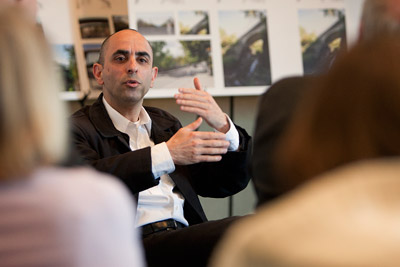Options for bridge barriers discussed at four presentations
By Susan Kelley

Ithaca residents and Cornell students, faculty and staff gathered throughout the day March 2 to ask questions and to comment on options for barriers to enhance the safety of seven bridges on and near the Cornell campus.
Architects Nader Tehrani and Dan Gallagher of NADAAA, a Boston, Mass., architecture firm hired by the Cornell administration, made four presentations on campus and at Ithaca venues on conceptual designs for each type of bridge. The goal was to generate discussion on the various alternatives. In total, about 250 people attended the four meetings.
A video of the presentation is available on CornellCast. Input can be e-mailed via the "Comments?" link on the Means Restriction Study for Bridges site.
The architects presented three options for each type of bridge (stone arch, pedestrian and vehicular). In their designs, they said they took many factors into account, from maintenance to how modifications, such as a glass panel, might affect people -- those who suffer from vertigo, for example. Most of all, they said, they sought to enhance the views from and of the bridges. "In questions of aesthetics, we've said that the most successful thing we could do for the city of Ithaca is to design something that could never be seen," Tehrani said.
Options for the two Stewart Avenue bridges include vertical steel bars that extend up and curve slightly in, and nets underneath the bridges made of tensile steel mesh that is virtually transparent at a distance of 15 feet or more.
The Thurston Avenue Bridge is more complex, given its heavy traffic load, thick railings and wide span. One possibility is to remove the current railings, extend mesh up from the bridge and onto the arch and install a car barrier along the sidewalk that could serve as a bench. Other options: suspend mesh under the bridge, or create a mesh overhang on the arch -- "a thin eyebrow that goes over it," Tehrani said.
A sheet of tempered glass pinned to the railing could preserve the views from the Stone Arch Bridge, Tehrani said. Or mesh could be suspended underneath, connected to either the bridge underside or the sides of the gorge.
Of the seven bridges, the Trolley Bridge has the most potential to become a destination, what Tehrani called "a piece of furniture" that looks out onto the gorge. In two of the options the architects propose removing the railings and covering the bridge, either with vertical bars over the walkway or with mesh draped over a series of steel-rod tripods. A third possibility is to extend mesh up along vertical supports.
Similarly, bars could extend over the Beebe Dam Bridge. Or mesh could cover it, swooping up on one side to mimic the dam view and down the other to mimic the gorge view. Mesh could also drape over steel supports.
On the Suspension Bridge, one possibility is to replace the current railings with a lighter version and a mesh curtain. Vertical bars could also be used or mesh suspended below the bridge.
Several people asked whether the mesh would collect leaves and other debris, and how much it would cost to maintain. The mesh openings, the architects said, could be as wide as eight inches, so debris could blow through depending on weather conditions.
University Architect Gilbert Delgado said Cornell will take maintenance costs into account when deciding which designs to develop further.
Greg Eells, associate director of Cornell's Gannett Health Services, hosted the presentations, saying bridge barriers are one part of Cornell's comprehensive approach to mental health promotion and suicide prevention.
Cornell officials will continue to collect public feedback. By April, they will ask the architects to develop one design for each bridge. By the end of May, Cornell expects to file a site plan review application for each design with the city of Ithaca planning board.
Media Contact
Get Cornell news delivered right to your inbox.
Subscribe